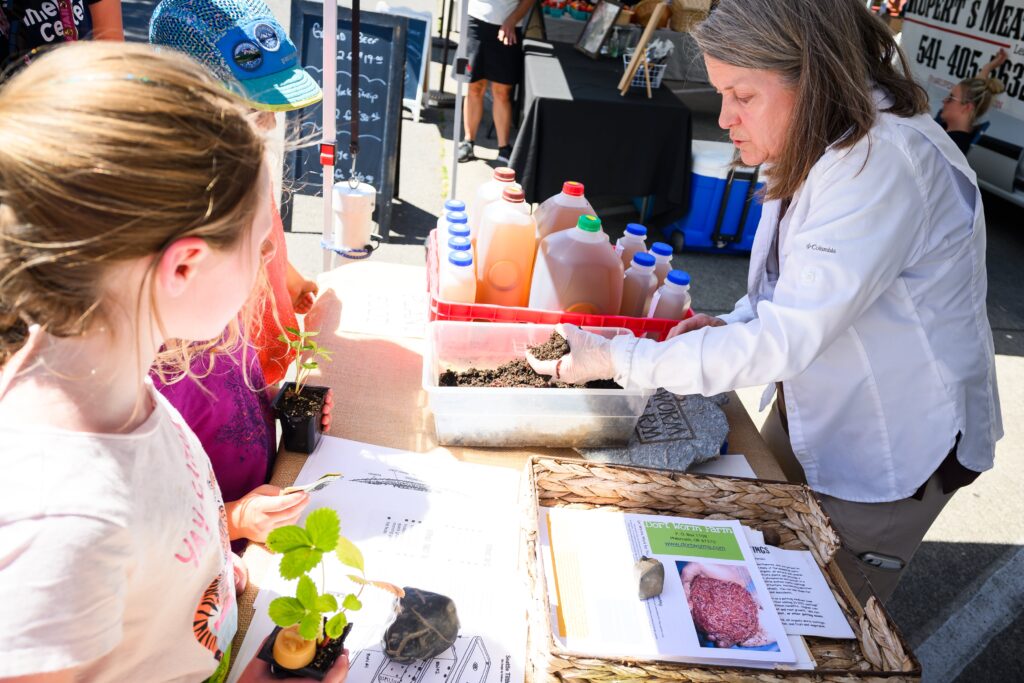The Wednesday Corvallis farmers’ market has tables selling fruits, vegetables, honey and other trinkets and treats.
Cynthia Dort’s table displays some more unusual items, including worms in bins of dirt and woven bags full of something labeled “castings.”
Next to all of that are pint bottles of liquid labeled “tea,” but also with an all-caps warning: “NOT FOR HUMAN CONSUMPTION.”
When a group of three kids appears at Cynthia’s table, she puts on a clear glove, palming a handful of dirt from a plastic container. When Cynthia flips her hand over, hundreds of redworms become visible, cascading out of her hand in a desperate attempt to get out of the sun.
In addition to her demonstration, Cynthia provides literature on redworms and composting and has information on how others can make their own mini farm.
“Cynthia’s always happy to help educate people on how to do that,” said Corvallis-Albany Farmers’ Markets Director Rebecca Landis.
Working her stand at the farmers’ market has helped Cynthia continue educating after she retired early from teaching fourth and fifth grade to have kids.
Cynthia was inspired to start worm farming by a different teacher who started homeschooling their kids and raised bees. Cynthia proposed the worm farm, thinking her kids would enjoy playing with worms while also learning about business.
Her husband, Jim, hadn’t always been interested in the worm farm. Jim’s favorite thing to do is teach, and he substitutes at Corvallis High School, where he had taught economics and social studies for 30 years before. He put up with the farm for the sake of his wife’s interest in it and their kids learning from it.
Cynthia joked with Jim about ending their farm once he stopped substitute teaching — so since then, his passion for teaching has kept the farm going.
“It’s the best occupation,” he said.
Cynthia and Jim taught their kids how to manage the farm. Their daughter was less connected to the process than their two sons, who loved to play with the little wigglers. In high school, their sons helped elevate the worm farm for a trade show and developed a website. The website is no longer running because shipping proved difficult for the farmers.
“I think it was a good experience for them,” Cynthia said.
Outside of Philomath, in the hills near Dort Worm Farm, deer can be found eating plants while squirrels and turkeys casually cross the road. On the farm, there are rows of cinder block beds, each containing dirt, worms and their castings. A barn contains their tools, including a harvester and Jim’s sorting station.
For the Dorts, worm farming is a lengthy operation. Jim feeds the worms hand-washed horse manure that is donated by their neighbors.
Jim scoops dirt out of the worm beds and puts it in the harvester, which separates the castings from the dirt and worms into black bins. After the harvester finishes running, Jim takes the dirt, still full of worms, and separates the two using a paint scraper.
Once Jim picks all the worms out of the dirt and places them in a separate bin, he removes the top layer of dirt to ensure no worms remain, as they tend to burrow to escape light.
“It’s a pretty simple process, but it’s also work-intensive,” Jim said.
Worms reproduce year-round, but they’re more likely to do so under specific conditions. The temperature of the bins they live in needs to be between 55 and 80 degrees. It’s important for the soil to be somewhat moist, and the soil needs to be neutral — not acidic or basic.
During the summer months, when it’s dry, the worms reproduce slowly. But when the Dorts are able to get the conditions just right, the number of worms on Jim’s countertop skyrockets.
“When our bins are really producing,” Jim says, “I love it.”
Cynthia steeps the tea she sells at the market almost like a regular herbal tea that one would find in the kitchen. But instead of being for drinking, the Dort Worm Farm Worm Tea is used as a fertilizer.
She steeps worm castings — a combination of dirt and worm vomit — in water for 24 hours with other additives, like rock powder and kelp.
In the past, the label didn’t always specify whether it could be consumed. The multiple times when customers tried to drink the tea proved that a warning was necessary.
— Molly Gribskov, McMinnville High School
— Frankie Kassell, Grant High School
This story was produced by student reporters as part of the High School Journalism Institute, an annual collaboration among The Oregonian/OregonLive, Oregon State University and other Oregon media organizations. For more information or to support the program, go to
oregonlive.com/hsji
.
High School Journalism Institute 2025
-
New resource helps researchers to track native bees in Oregon
-
Oregon county fights mental health crisis in a way few others are
-
Corvallis installs signs reflecting Marys Peak creeks’ new Indigenous names
-
Screaming is a good sign: How a TikTok-famous rescued barn owl is doing now
-
Bridges Program in Corvallis changes its ‘last resort’ narrative, gives students a second chance





More Stories
Retired teachers channel their passion for education into Philomath worm farm
Retired teachers channel their passion for education into Philomath worm farm
Retired teachers channel their passion for education into Philomath worm farm